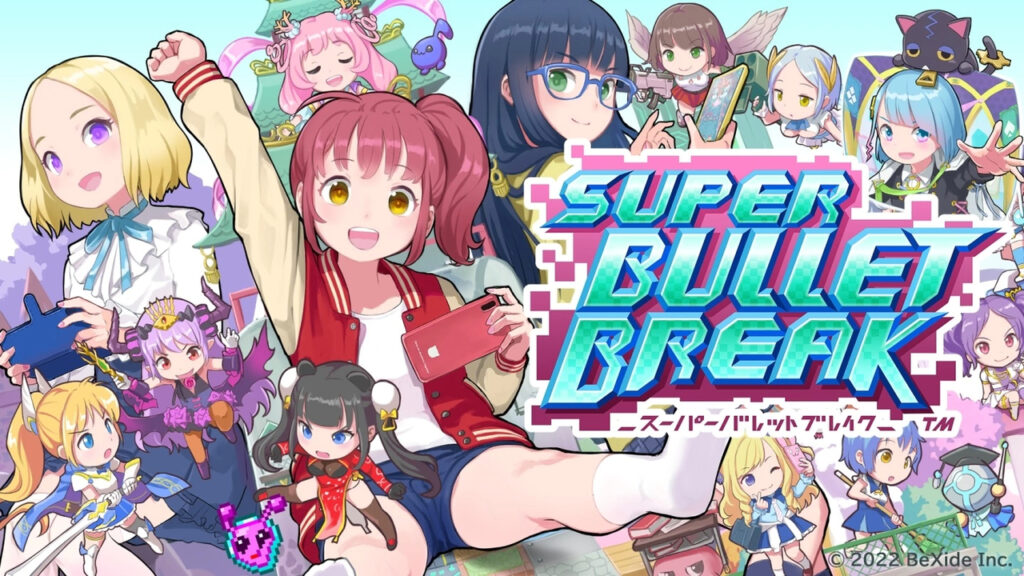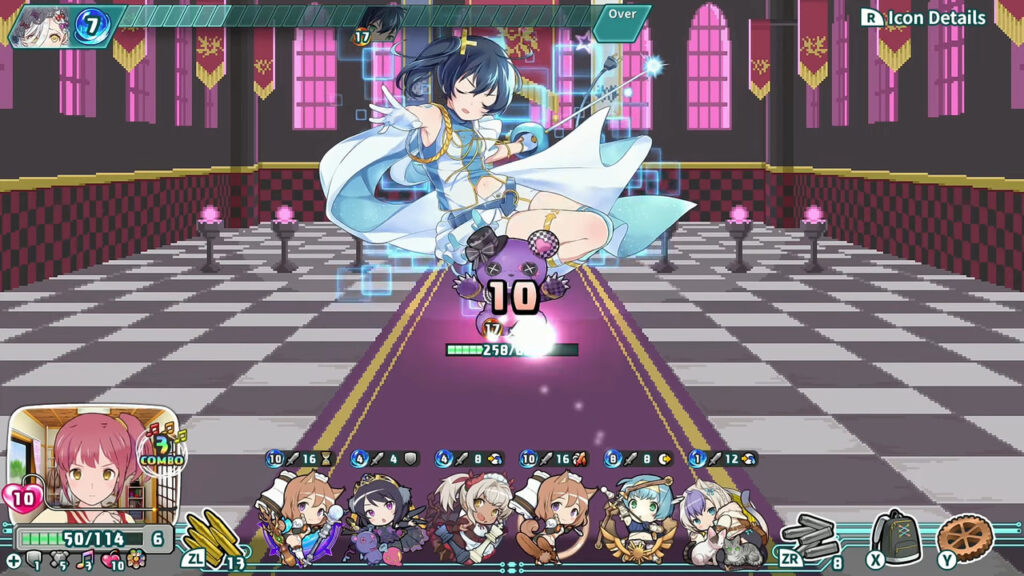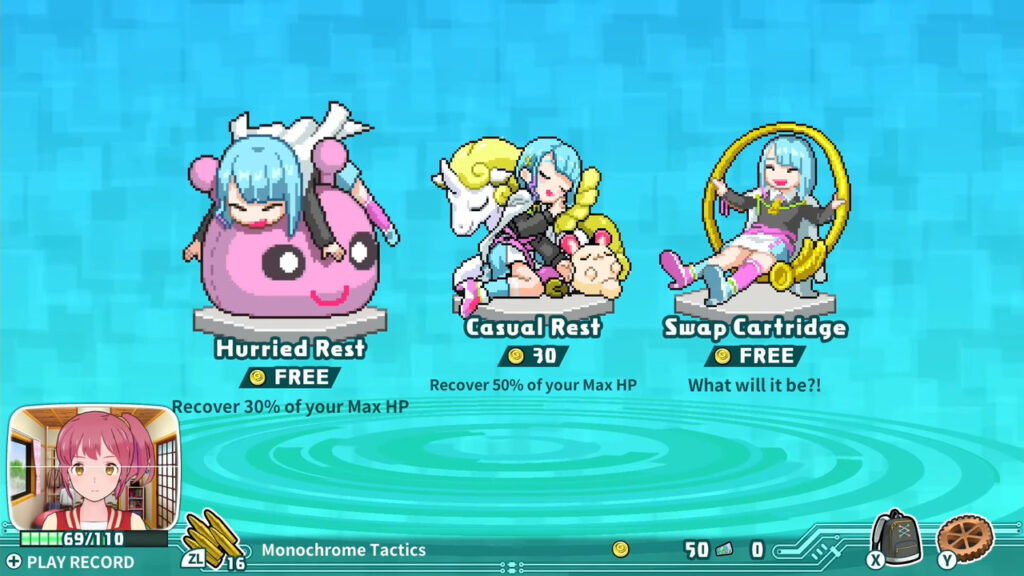
Developer: BeXide Inc.
Publisher: PQube
Platform: Switch, PC, PS4
Tested on: Switch
Super Bullet Break – Review
Like ‘em or hate ‘em, there is no denying that gacha mechanics are controversial, as games built around them typically involve predatory microtransactions and limited-time events that rely on FOMO. Another factor with gacha games is that they try to appeal to their audience through lewd artwork involving anime “waifus” in skimpy outfits, because as the old saying goes; sex sells. As such, you can imagine that warning signs started flashing in our minds when publisher PQube asked us to take a look at Super Bullet Break, a new roguelike deck builder with gacha mechanics from developer BeXide Inc. Fortunately, Super Bullet Break manages to avoid the pitfalls typically associated with games like this. Read on to find out how it’s different, and why you should actually consider picking this one up if you like gacha games.
Story
Although there is an opening scene that explains Super Bullet Break’s premise, the story isn’t really fleshed out beyond this initial setup. The game starts out with a conversation between Akari, a self-declared “pro gamer” and Nayuta, who explains what’s going on through a heavy amount of expository dialogue. As it stands, rogue AI known as Singulaladies are corrupting video games and turning them into variants of a game called Bullet Break. In order to restore the corrupted video games to their normal state, Akari must team up with Bullet Break’s protagonist, Blackcat, and play through the corrupted video games, beating each Singulalady at the end. Of course, our protagonist pair must also get to the root of who’s causing all of this and deal with them too. Akari isn’t the only protagonist either -more gamer girls make their appearance later on in the game’s narrative as well. The story premise is simple enough and filled with lots of meta humor about video games and self-referential jokes, and while the overall story felt muddled, we still enjoyed the writing style.
Graphics
We can’t tip-toe around Super Bullet Break’s character designs, of course: the game is filled to the brim with fan service. The cutesy girls are the personifications of “bullets” -hence the title- and are presented in a variety of styles, from the realistically proportioned enemy designs (well, realistically proportioned by anime standards, at least) to the chibi-esque “cards” and pixelated sprites. This mish-mash of styles works surprisingly well, and although the character designs can be considered “lewd” occasionally, the game never really crosses the line and becomes uncomfortable, although we’d still refrain from playing the game in public. We’ve seen far more controversial stuff, even on the Switch, and your mileage may vary, but we felt the character designs were relatively tame compared to other fan service-y titles like Seven Pirates H or outright hentai titles like Neko Secret Room. One issue we did have with Super Bullet Break’s visuals was that the on-screen text was very small, to the point that it almost felt illegible in handheld mode.
Sound
While Super Bullet Break’s visuals never cross the line, we did feel awkward when it came to the voice acting. Whenever a new girl is introduced, she gets a few audible lines of dialogue in Japanese, and more often than not, these voice lines involve heavy breathing and moaning. Given that the game’s OST is rather unexciting and quickly becomes stale and repetitive, and the sound effects aren’t anything special either, we actually resorted to turning off the sound of the game and listening to something else while we were playing the game.
Gameplay
Beneath Super Bullet Break’s colorful surface lies a tactical roguelike deck-building game that makes heavy use of gacha mechanics. We’re usually averse to digital card games that rely on random pulls as they tend to reek of microtransactions, but these are nowhere to be found here. Beyond the initial cost of the base game, Super Bullet Break won’t try to pry money from your wallet. The cards that you obtain are earned in-game, and while the game does lean heavily into the concept of rare cards and you’ll occasionally go on a bad streak, it’s all for fun here rather than predatory money grabbing. This is further emphasized by the game’s rogue-like nature: once you complete a run, your game resets, and you’ll start a new run without keeping your cards, although unlocked characters stay in your gallery.
Such a run comprises a series of card battles with a deck that you customize with cards you’ve obtained. The game’s world is represented through nodes on a map and you move from node to node, each one of these triggering a random event. The majority of these are battles, but you’ll occasionally end up on a node that heals you, allows you to buy items that help power your deck, or obtain new cards. At the end of a map section, you’ll face a boss battle, and these are probably the most fun part of the game. There is a sense of progress here too, thanks to the customizable decks, although a streak of bad luck can essentially ruin a run.
Balancing a deck is key here, of course, and Super Bullet Break uses an interesting tactical system based on how many turns it takes to perform certain attacks. More powerful attacks take more time to build up, and you’re often juggling between using less powerful but faster attacks that add up, or dishing out massive damage. Enemies typically go for the latter option, giving you ample time to try and take them out before they rip through your characters. Admittedly, the game has some issues explaining its mechanics -something that is lampshaded in-game with a joke about how nobody reads tutorials anymore- and it took us a couple of runs before we really got to grips with Super Bullet Break’s mechanics. The combo system in particular really opened up our possibilities but this was introduced fairly late into our first run and it meant we had some issues judging the game’s difficulty level as things seemed needlessly hard up until we reached that point.
This uneven difficulty curve is perhaps Super Bullet Break’s biggest hurdle to overcome, especially for those new to the genre. Our first few battles felt needlessly difficult because abilities and critical skills felt like they simply weren’t doing enough. Combined with the poor explanation of how these are used properly, we struggled early on, especially during our first boss battle -which was essentially still part of the game’s tutorial. Once we mastered this second layer of mechanics, new combinations opened up and we had fun crafting combos using the game’s roster of over 160 characters.
It goes without saying that you’re getting a lot of bang for your buck here, once you get past the game’s rough start. The potential deck combinations are nearly limitless and completionists certainly have their work cut out for them if they aim to obtain every single character at least once. While Super Bullet Break isn’t an incredibly addictive game, it’s fun enough that we can see ourselves periodically returning to it. The fact that the game doesn’t have limited time items or banks on FOMO despite being built around gacha mechanics also helps tremendously of course.
Conclusion
While Super Bullet Break isn’t without its flaws, there is a lot to like here. If you’re a fan of the rush that comes with obtaining rare gacha items but don’t like spending hundreds or even thousands of dollars on a full set of digital cards, then this game might be up your alley. You need to get past the initial unbalanced difficulty curve, but once you do, Super Bullet Break opens up and brings you a fun roguelike deck-building game brimming with fan service, without breaking the bank.
Super Bullet Break - Review,









No Comments